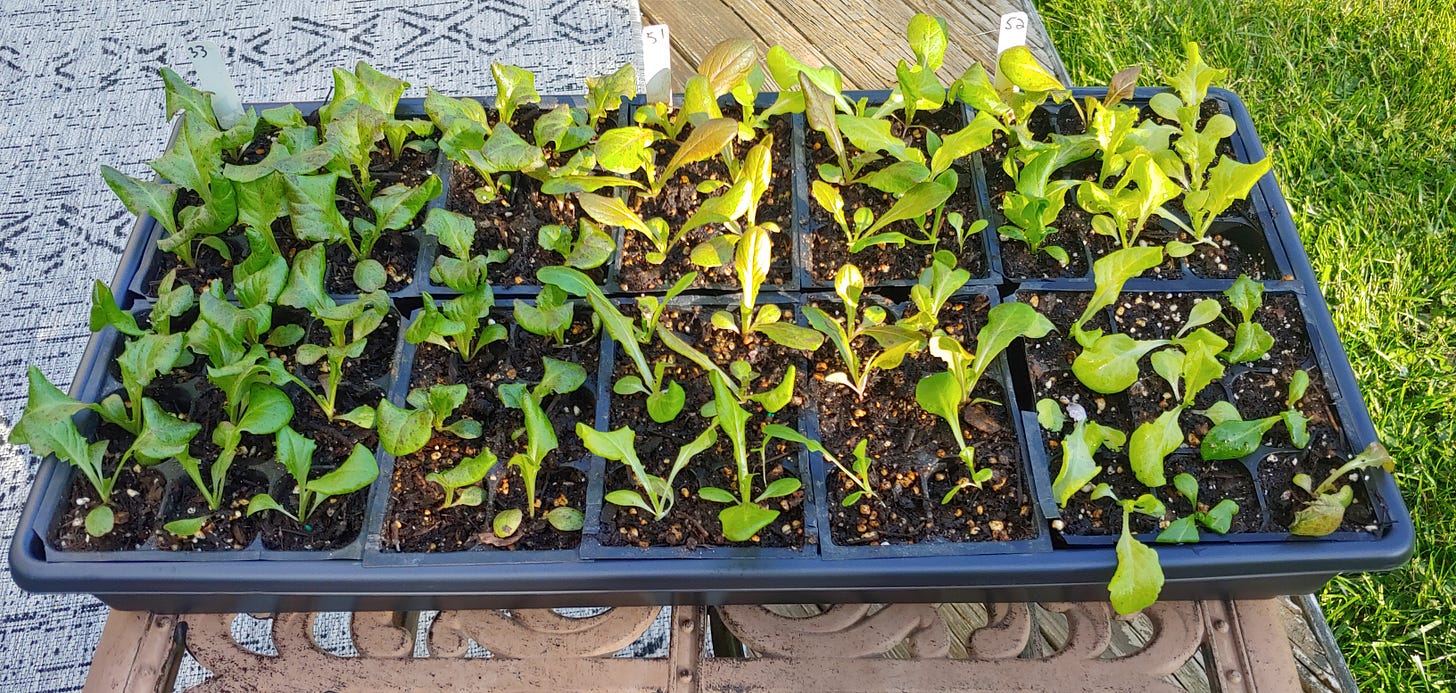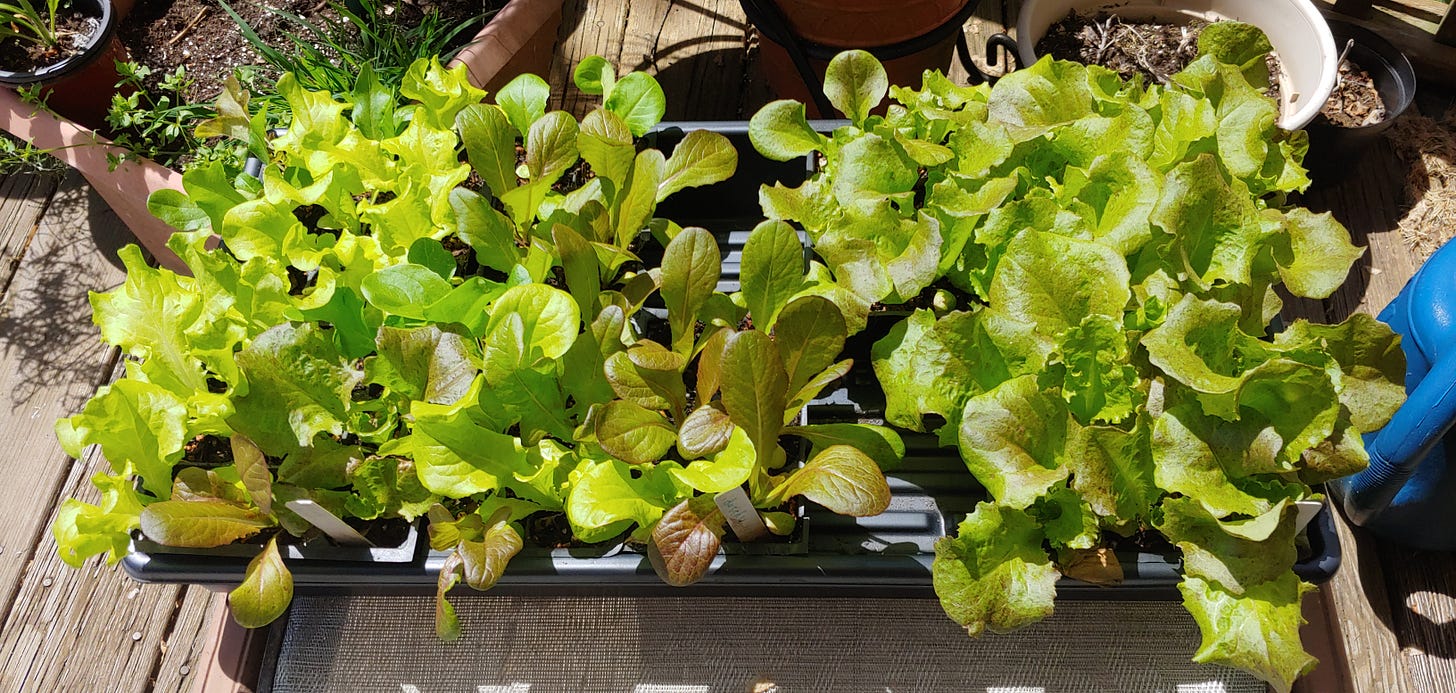I wanted to offer some advice to new gardeners, particularly those new to lettuce.
I love garden lettuce and other greens. Lettuce is easy to grow, and is one of those garden vegetables that is way better than store bought. But some people have trouble growing it, and I wanted to discuss a few issues.
Rather than start from the beginning, I'll start with the photo and work backwards. This is a flat of leaf lettuce seedlings that I started indoors from seed on April 20. For reference, I took the photo on May 6. A lot of people would look at this and say "Hey Tom, this stuff is ready to go into the garden." But they would be wrong. It's not ready. It might be ready by the weekend, but it's not quite ready now. If I transplant it now, I'll probably lose at least a third of the plants.
Lettuce is easy but temperamental, and it requires specific treatment. You can direct sow it in the garden -- and I do that if I'm really lazy, particularly when we get to fall planting -- but I've found that I can cater to the plants better if I start them indoors, and I can also space them properly in the garden this way. That said, don't start lettuce indoors without supplemental lighting. Without lighting, you will invariably get leggy plants. And leggy lettuce is tough to deal with.
So I start them indoors by scattering seed in a small pot. I let them germinate and compete for about ten days, and then I separate them and transplant to cubes in a flat, much like you see here. The advantage to this is that I can select the strongest plants, and, if I plant a mix of varieties (which I often do), I can ensure that I get enough of each variety. Once in the cubes, they stay under the lights for about a week, maybe a little less.
When I see that they have caught on, I start to expose them to the outdoors. And that brings us to the photo. The plants in the photo are doing fine and growing quickly. But they have not been fully hardened off, and have not worn out their welcome in their containers. That will change in a few days, but that transformation must happen before putting them in the ground. I will try to remember to post an "after" photo so that you can see the difference. Those plants will have a 100% survival rate when transplanted …squirrels aside.
*** Update… Here’s a photo of the same plants a week later (some are missing because I gave them away). These plants are ready for action, and all will survive after I transplant them, which will be soon…
You would think that a few days outside in the cubes would not make that much of a difference. But it does. Lettuce seedlings are very fragile, especially when started indoors. Indoor lettuce seedlings are not equipped to survive in the much harsher surroundings of garden soil. Just the simple act of watering them can bury them in mud, never to be seen again. It only takes one windy or rainy — or even excessively sunny and hot — day, and… kaput.
So, you might ask, why not just sow seed directly into the garden? And, as I said, I do that occasionally. It works. The challenge is that you almost always sow too thickly. And then you end up needing to thin the plants. I don’t know about you, but thinning is one of my least favorite and most heartbreaking garden jobs — I would much prefer to weed than thin. Thinning reminds me that I’ve created a lot of tedious and unnecessary work, and have wasted a bunch of seeds in the process. In other words, thinning makes me feel lousy about myself. So I avoid it.
If I start the seeds indoors, I sow far fewer seeds, and I end up with individual plants in cubes, as the photo shows. When the time is right, I can then space those plants in the garden perfectly, about three inches apart. I can fit a lot of lettuce seedlings in one of my 32” x 32” containers — more than my family can eat, even with a salad every night at dinner and sometimes at lunch. As an aside, I don’t pick whole plants; I pick the large outer leaves, allowing the inner leaves to replace them. That way, you can start picking early and have a continuous supply. I can typically pick from a planting every day for four to six weeks before the lettuce begins to get old and starts going to seed. That is why I do succession planting — but that is a topic for another post.
For what it’s worth (about $40, actually…), this probably knocks about $40 off the grocery bill during that time. And the store lettuce cannot match the quality, since store varieties are bred for shipping rather than taste. Lettuce season indeed is one of my favorite times of the year. But the road to excellent garden lettuce is fraught. So be patient, grasshopper, and harden off those seedlings.
NB: You can join my Facebook garden group here.






